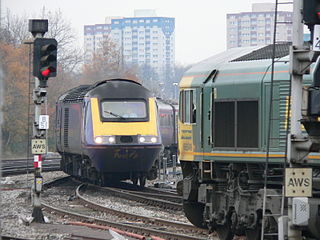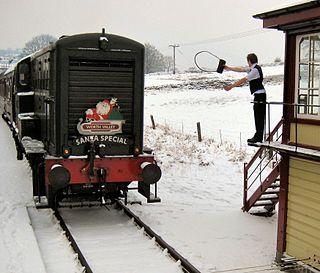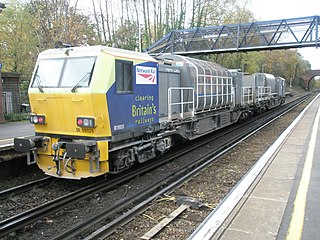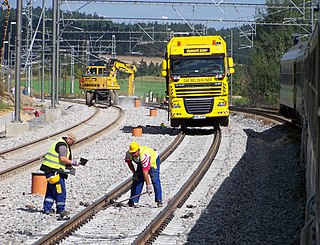
Permissive Working [1] on a railway in the United Kingdom allows more than one train at a time to be on the same line in a block section, a signal section or a dead-end platform line.

Permissive Working [1] on a railway in the United Kingdom allows more than one train at a time to be on the same line in a block section, a signal section or a dead-end platform line.
The areas where Permissive Working is allowed are given in Table A of the Network Rail Sectional Appendix.
Even where it is not authorised, a shunting movement can be allowed to enter a portion of line that is already occupied providing that it is for the purpose of:
When it is permitted to drive a train towards the rear of another train, such as where trains queue to enter or exit a depot, the driver must:

A railway signal is a visual display device that conveys instructions or provides warning of instructions regarding the driver’s authority to proceed. The driver interprets the signal's indication and acts accordingly. Typically, a signal might inform the driver of the speed at which the train may safely proceed or it may instruct the driver to stop.

Railway signalling (BE), also spelled railway signaling (AE), is a system used to direct railway traffic and keep trains clear of each other at all times. Trains move on fixed rails, making them uniquely susceptible to collision. This susceptibility is exacerbated by the enormous weight and momentum of a train, which makes it difficult to quickly stop when encountering an obstacle. In the UK, the Regulation of Railways Act 1889 introduced a series of requirements on matters such as the implementation of interlocked block signalling and other safety measures as a direct result of the Armagh rail disaster in that year.

In railway signalling, a token is a physical object which a train driver is required to have or see before entering onto a particular section of single track. The token is clearly endorsed with the names of the section it belongs to. A token system is more commonly used for single lines because of the greater risk of collision in the event of a mistake being made by a signaller or traincrew, than on double lines.
The Train Protection & Warning System (TPWS) is a train protection system used throughout the UK passenger main-line railway network, and in Victoria, Australia.

A signal passed at danger (SPAD), known in the United States as a stop signal overrun and in Canada as passing a stop signal, is an event on a railway where a train passes a stop signal without authority. In the United States and Canada, this may be known colloquially as running a red, though this idiom principally refers to automobiles passing red traffic signals.

The Multiple-purpose Vehicle or MPV is a purpose-built departmental derivative of a diesel multiple unit. Twenty-five two-car units were ordered by Railtrack to enable it to replace its varied collection of ageing departmental vehicles, many of which were converted from redundant passenger stock.

Centralized traffic control (CTC) is a form of railway signalling that originated in North America. CTC consolidates train routing decisions that were previously carried out by local signal operators or the train crews themselves. The system consists of a centralized train dispatcher's office that controls railroad interlockings and traffic flows in portions of the rail system designated as CTC territory. One hallmark of CTC is a control panel with a graphical depiction of the railroad. On this panel, the dispatcher can keep track of trains' locations across the territory that the dispatcher controls. Larger railroads may have multiple dispatcher's offices and even multiple dispatchers for each operating division. These offices are usually located near the busiest yards or stations, and their operational qualities can be compared to air traffic towers.

Catch points and trap points are types of turnout which act as railway safety devices. Both work by guiding railway carriages and trucks from a dangerous route onto a separate, safer track. Catch points are used to derail vehicles which are out of control on steep slopes. Trap points are used to protect main railway lines from unauthorised vehicles moving onto them from sidings or branch lines. Either of these track arrangements may lead the vehicles into a sand drag or safety siding, track arrangements which are used to safely stop them after they have left the main tracks.

Absolute block signalling is a British signalling scheme designed to ensure the safe operation of a railway by allowing only one train to occupy a defined section of track (block) at a time. This system is used on double or multiple lines where use of each line is assigned a direction of travel.

The railway signalling system used across the majority of the United Kingdom rail network uses lineside signals to control the movement and speed of trains.
Australian railway signalling varies between the states of Australia, because each railway system was established under the different colonial governments with separate legislation. Just as with the notorious variation of Australian rail gauges, there are differing signal systems. The systems in New South Wales generally follow British precedents, although American influence has increased somewhat since the 1990s. Victoria uses American-style speed signalling on its main lines. That can cause confusion where the systems meet.

An axle counter is a system used in railway signalling to detect the clear or occupied status of a section of track between two points. The system generally consists of a wheel sensor and an evaluation unit for counting the axles of the train both into and out of the section. They are often used to replace a track circuit.
The Toronto subway uses a variety of signalling systems on its lines, consisting of a combination of fixed block signalling and moving block signalling technologies.

In traffic engineering, there are regional and national variations in traffic light operation. This may be in the standard traffic light sequence or by the use of special signals.

Signalling block systems enable the safe and efficient operation of railways by preventing collisions between trains. The basic principle is that a track is broken up into a series of sections or "blocks". Only one train may occupy a block at a time, and the blocks are sized to allow a train to stop within them. That ensures that a train always has time to stop before getting dangerously close to another train on the same line. The block system is referred to in the UK as the method of working, in the US as the method of operation, and in Australia as safeworking.

On a railway, single-line working refers to the practice where, when one line out of the two lines is blocked, trains are able to use the other in either direction. This is usually when a line is out of use for maintenance, or because of damage, obstruction or train failure.
The Orgreave Train Collision occurred on 13 December 1926 near Orgreave Colliery signal box on the Great Central Railway line about 4+1⁄2 miles (7.2 km) east of Sheffield. A goods train had collided with a preceding goods train on the same line, and the wreckage had obstructed the adjacent passenger line.

The Knowle and Dorridge rail crash was a fatal rail crash that occurred at Dorridge railway station in the West Midlands, England, on 15 August 1963. Three people died in the crash after a signalman's error routed a small freight train into the path of an express passenger train which slowed but could not stop before colliding with it.
Swiss railway signalling describes the railway signalling systems used in Switzerland by the different railway companies. There are two main types of signal, used up to 160 km/h, above which speed cab signalling is required.

The application of railway signals on a rail layout is determined by various factors, principally the location of points of potential conflict, as well as the speed and frequency of trains and the movements they require to make.